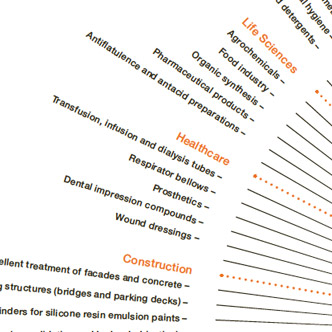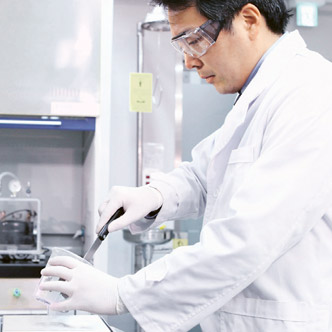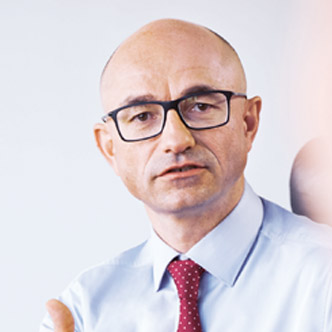11 Provisions for Pensions
For WACKER Group employees, there are various post-employment pension plans, which depend on the legal, economic and fiscal conditions prevailing in the respective countries. These pension plans generally take account of the employees’ length of service and salary levels.
The company pension plan makes a distinction between defined contribution and defined benefit plans. Defined contribution plans lead to no further obligation for the company beyond paying contributions into special-purpose funds. WACKER has both defined-contribution and defined-benefit plans, which are financed in part by Pensionskasse der Wacker Chemie VVaG or by funds. Pension obligations result from defined benefit plans in the form of entitlements to future pensions and ongoing payments for eligible active and former employees of the WACKER Group and their surviving dependents. The various pension plans basically ensure employees either a life-long pension on the basis of their average salary during employment at WACKER (career average plan) or lump-sum payments.
The Group maintains the following retirement benefit plans:
Retirement Benefits Supplied by the Company Pension Fund
Employees at Wacker Chemie AG and other German Group companies are granted a basic pension model via Pensionskasse der Wacker Chemie VVaG, a legally independent German pension fund. The pension fund is financed by member and company contributions. The payments comprise old-age, disability and surviving dependents’ benefits.
The pension fund is a small mutual insurance company within the meaning of Section 210 of the German Insurance Supervision Act and is regulated by Section 233 (1) of this act. It is thus subject to the regulations that apply to German insurers and is monitored by the Federal Financial Supervisory Authority (BaFin). There are statutory minimum financing obligations.
Employees who joined the pension plan before the end of 2004 receive guaranteed payments based on a defined-benefit amount, which is to be taken into consideration in determining pension obligations. The pension payment is the same regardless both of the employee’s age when paying contributions and of the interest generated from assets. A new basic-pension model applies for employees who joined the pension fund after 2004. Under that model, the benefits are based on guaranteed interest rates and the benefit amount depends on the age at which the employee pays contributions. Annual profit distributions can increase the future payment. In addition, employees in Germany may make voluntary payments to the “PK+” supplementary insurance fund of Pensionskasse der Wacker Chemie VVaG. Primarily, contributions in connection with retirement benefit plans governed by the collective bargaining agreements concerning one-off payments and retirement benefits, and “Working Life and Demography” are paid into the voluntary supplementary insurance fund.
In fiscal 2016, accounting treatment of the plans for employees in Germany who joined the company after 2004 was changed. Up until fiscal 2015, WACKER treated these plans as defined contribution plans. Since interest rates remained at very low levels, WACKER reassessed the plans in 2016 because the probability of their being utilized had risen and recognized them as defined benefit plans. As a consequence of this change, the present value of the defined benefit obligation rose by €143.1 million in 2016 and was recognized in other comprehensive income. At the same time, additions to plan assets in the amount of €138.6 million were recognized in other comprehensive income. These effects are shown under the line items “Gains / losses from changes in experience-based assumptions” and “Gains / losses from plan assets without amounts already recognized in interest income” in the table “Changes in the Net Liability of Defined Benefit Obligations.”
Direct Commitments of the WACKER Group
In addition to the pension fund commitments, employees in Germany receive direct commitments in the form of an additional pension. The additional pension insures that part of an employee’s salary that exceeds the pension insurance contribution assessment ceiling. Employees who joined the company before the end of 2004 – and their surviving dependents – receive a pension. The amount of that pension depends on the average salary earned during the period of employment with WACKER (career average plan). For employees who joined the plan as of 2005, a certain percentage of the salary exceeding the pension insurance contribution assessment ceiling is paid in. This capital accrues interest. The benefits may be paid out as a life-long pension or, in the case of commitments made from 2005 onward, as a lump sum. Employees and their surviving dependents are eligible to receive benefits. Employee entitlements are included when measuring pension obligations, regardless of whether the employees joined the company before the end of 2004 or after the beginning of 2005.
Executive Board members are granted individual pension commitments. For more information on Executive Board member pension plans, please refer to the Compensation Report.
Employees in Germany with salaries above the standard pay scale may pay into an employee-financed pension plan (deferred compensation). This plan affords employees the option of converting part of their future salary claims into equivalent pension capital. Pension capital accrues interest according to the date the pension plan was entered into (commitment) at either 7 percent (1996 – 2001), 6 percent (2002 – 2010) or 5 percent (2011 – 2013). Plans bearing 7 percent or 6 percent interest may be drawn in the form of either a pension or a lump sum. Plans bearing 5 percent interest are paid out exclusively in lump-sum form. Since 2015, management employees have been able to contribute a portion of their salary to an employee-financed pension plan with a variable interest rate. The variable interest rate is linked to the five-year running yield on German bearer bonds and amounts to at least 2.5 percent and at most 5 percent. Disbursement is as a lump sum only. Pension commitments made before or on December 31, 2000 are measured (in accordance with the projected unit credit method) at the present value of years’ service to date or years served to retirement, whereas any commitments made on or after January 1, 2001 are measured at the present value of the defined benefit obligation or at the equivalent of the accumulated capital.
Pension entitlements in Germany are protected against insolvency by the pension guarantee fund (Pensionssicherungsverein a. G.). This insolvency insurance is capped. There are no statutory minimum financing obligations.
Pension Commitments outside of Germany
Various pension plans are available for employees of foreign subsidiaries, subject to the statutory provisions applicable in the respective countries. With the exception of the US pension plans, these pension plans are not material to the Group.
In the US, defined benefit plans exist for employees of Siltronic Corporation, Portland, and Wacker Chemicals Corporation, Adrian. However, both plans were closed for new applications effective after December 31, 2003, and defined benefits are carried only for legacy policies. Retirement benefits are paid out from age 65 in the form of a monthly pension and are based on the last average salary paid. Special rules apply to early retirement as of age 55 depending on the employee’s years of service. In view of their pension-like character, obligations relating to medical care for retired employees and severance payments are likewise included under pension provisions. New employees in the USA are offered only defined contribution plans.
The present value of defined benefit plans may be reconciled with the provisions recognized in the balance sheet as follows:
Net Liability of Defined Benefit Obligations
| Download XLS |
|
||||||||||||
€ million |
Dec. 31, 2016 |
Dec. 31, 2015 |
||||||||||
|
Germany |
International |
Total |
Germany |
International |
Total |
||||||
|
|
|
|
|
|
|
||||||
|
|
|
|
|
|
|
||||||
Present value of the at least partially fund-financed defined benefit obligations |
2,806.7 |
234.1 |
3,040.8 |
2,230.2 |
222.8 |
2,453.0 |
||||||
Fair value of plan assets |
-1,917.3 |
-177.3 |
-2,094.6 |
-1,660.5 |
-160.4 |
-1,820.9 |
||||||
Funded status |
889.4 |
56.8 |
946.2 |
569.7 |
62.4 |
632.1 |
||||||
Present value of unfunded defined benefit obligations |
1,141.7 |
19.9 |
1,161.6 |
963.4 |
16.2 |
979.6 |
||||||
Provisions for pensions and similar obligations |
2,031.1 |
76.7 |
2,107.8 |
1,533.1 |
78.6 |
1,611.7 |
||||||
|
|
|
|
|
|
|
||||||
Changes in the Net Liability of Defined Benefit Obligations
| Download XLS |
|
|
|||||
€ million |
Present value of pension plan obligations |
Market value of plan assets |
Total |
|||
|
|
|
|
|||
|
|
|
|
|||
As of January 1, 2015 |
3,500.3 |
-1,742.1 |
1,758.2 |
|||
Current service cost |
87.5 |
– |
87.5 |
|||
Interest expense / income |
85.1 |
-43.6 |
41.5 |
|||
Administrative expenses paid from plan assets |
– |
0.7 |
0.7 |
|||
Past service cost / effects of settlements and curtailments |
1.4 |
– |
1.4 |
|||
|
|
|
|
|||
Remeasurements |
|
|
|
|||
Gains (–) / losses (+) from plan assets without amounts already recognized in interest income |
– |
-23.3 |
-23.3 |
|||
Gains (–) / losses (+) from changes in demographic assumptions |
-3.5 |
– |
-3.5 |
|||
Gains (–) / losses (+) from changes in financial assumptions |
-283.3 |
– |
-283.3 |
|||
Gains (–) / losses (+) from changes in experience-based assumptions |
95.7 |
– |
95.7 |
|||
Effects of exchange-rate differences |
24.5 |
-16.3 |
8.2 |
|||
Contributions by |
|
|
|
|||
Employer |
– |
-44.2 |
-44.2 |
|||
Pension plan beneficiaries |
10.3 |
-10.3 |
– |
|||
Pension payments |
-85.4 |
58.2 |
-27.2 |
|||
As of December 31, 2015 |
3,432.6 |
-1,820.9 |
1,611.7 |
|||
|
|
|
|
|||
Current service cost |
75.9 |
– |
75.9 |
|||
Interest expense / income |
96.6 |
-52.5 |
44.1 |
|||
Administrative expenses paid from plan assets |
– |
0.8 |
0.8 |
|||
Past service cost |
0.4 |
– |
0.4 |
|||
Effects of settlements |
-12.7 |
11.8 |
-0.9 |
|||
|
|
|
|
|||
Remeasurements |
|
|
|
|||
Gains (–) / losses (+) from plan assets without amounts already recognized in interest income |
– |
-215.2 |
-215.2 |
|||
Gains (–) / losses (+) from changes in demographic assumptions |
-0.1 |
– |
-0.1 |
|||
Gains (–) / losses (+) from changes in financial assumptions |
545.6 |
– |
545.6 |
|||
Gains (–) / losses (+) from changes in experience-based assumptions |
130.7 |
– |
130.7 |
|||
Effects of exchange-rate differences |
9.1 |
-5.9 |
3.2 |
|||
Contributions by |
|
|
|
|||
Employer |
– |
-61.5 |
-61.5 |
|||
Pension plan beneficiaries |
11.2 |
-11.2 |
– |
|||
Pension payments |
-89.0 |
60.0 |
-29.0 |
|||
Change in the scope of consolidation |
2.1 |
– |
2.1 |
|||
As of December 31, 2016 |
4,202.4 |
-2,094.6 |
2,107.8 |
|||
|
|
|
|
|||
Assumptions
The pension obligations are calculated by taking account of company-specific and country-specific biometric calculation principles and parameters. The calculations are based on actuarial valuations that factor in the following parameters:
| Download XLS |
|
|
|
||||
% |
2016 |
2015 |
||||
|
|
|
||||
|
|
|
||||
|
||||||
Actuarial Assumptions |
|
|
||||
Germany |
|
|
||||
Discount rate |
1.94 |
2.75 |
||||
Salary growth rate |
2.5 |
2.5 |
||||
Pension growth rate1 |
|
|
||||
Basic and supplementary pension |
1.8 / 1.0 |
1.8 / 1.0 |
||||
Deferred compensation |
2.5 / 1.0 |
2.5 / 1.0 |
||||
|
|
|
||||
USA |
|
|
||||
Discount rate |
3.92 |
4.2 |
||||
Salary growth rate |
3.0 |
2.0 / 3.0 |
||||
|
|
|
||||
Life expectancy calculations in Germany are based on Prof. Klaus Heubeck’s modified 1998 guideline tables. The pension fund portfolio (basic pension model) is based on the official mortality tables (reduction of male mortality to 75 percent of the guideline table value, and 85 percent for females). The portfolio for other pension commitments is based on a reduction of male mortality to 60 percent of the Heubeck values and 85 percent for women, which takes into account in particular the recognized connection between life expectancy and the amount of pension paid (“Influence of socio-economic status”). In the USA, the gender-specific RP-2014 mortality tables (Scale SoA MP-2014) are used for both pensioners and pension beneficiaries. The RP-2014 mortality table was extrapolated back to the year 2007 and a modified version of the MP-2014 table was used as a basis for future periods.
The discount rates and salary increase rates used in calculating the pension obligation were determined in line with the general economic situation and by applying uniform standards. The discount rate is based on a yield curve that is derived from the yields of country-specific, high-grade, fixed-interest corporate bonds with maturities corresponding to the pension obligations. The discount rate takes account of the WACKER-specific, expected future cash flows for these obligations.
Sensitivity Analysis
The following sensitivity analysis involves an adjustment of only one assumption – i. e. the other assumptions remain unchanged from the original valuation, so that the sensitivity of each individual assumption can be observed in isolation. As a consequence, possible correlation effects between the individual assumptions cannot be taken into consideration.
The following table shows the possible changes in the present value of pension obligations resulting from changes in the basic actuarial assumptions.
Sensitivity Analysis
| Download XLS |
|
|
|
||||||
|
Dec. 31, 2016 |
Dec. 31, 2015 |
||||||
|
Defined benefit obligation in € million |
Change (%) |
Defined benefit obligation in € million |
Change (%) |
||||
|
|
|
|
|
||||
|
|
|
|
|||||
Present value of pension obligations as of the reporting date |
4,202.4 |
|
3,432.6 |
|
||||
Present value of pension obligations if |
|
|
|
|
||||
the discount rate increases by 0.5 percentage points |
3,820.4 |
-9.1 |
3,154.7 |
-8.1 |
||||
the discount rate decreases by 0.5 percentage points |
4,643.1 |
10.5 |
3,750.3 |
9.3 |
||||
salaries increase by 0.5 percentage points |
4,242.1 |
0.9 |
3,465.8 |
1.0 |
||||
salaries decrease by 0.5 percentage points |
4,163.2 |
-0.9 |
3,399.6 |
-1.0 |
||||
future pension increases are 0.25 percentage points higher |
4,330.4 |
3.0 |
3,526.0 |
2.7 |
||||
future pension increases are 0.25 percentage points lower |
4,080.9 |
-2.9 |
3,343.3 |
-2.6 |
||||
life expectancy goes up by one year |
4,363.9 |
3.8 |
3,553.3 |
3.5 |
||||
|
|
|
|
|||||
Composition of Plan Assets
Pensionskasse der Wacker Chemie VVaG invests plan assets in accordance with statutory requirements and the terms of its by-laws. The company pension fund invests nearly half of its assets in equity funds and fixed-income funds. The other half is invested directly in promissory notes (German Schuldscheine), real estate, real estate mortgages and private equity. The remaining part of assets is retained for liquidity purposes. The investment strategy follows the investment guideline provided by the executive board of the pension fund.
The plan assets of pension funds set up in the US are invested mainly in stocks and funds in accordance with the applicable investment rules. The composition of plan assets for the Group is shown in the following table:
Composition of Plan Assets
| Download XLS |
|
||||||||||||
€ million |
Dec. 31, 2016 |
Dec. 31, 2015 |
||||||||||
|
Market prices listed in an active market |
No listing in an active market |
Total |
Market prices listed in an active market |
No listing in an active market |
Total |
||||||
|
|
|
|
|
|
|
||||||
|
|
|
|
|
|
|
||||||
Real estate |
– |
347.1 |
347.1 |
– |
274.5 |
274.5 |
||||||
Loans / fixed-interest securities |
734.3 |
425.8 |
1,160.1 |
664.4 |
438.6 |
1,103.0 |
||||||
Shares / funds |
274.8 |
178.7 |
453.5 |
246.0 |
138.9 |
384.9 |
||||||
Cash and cash equivalents |
– |
133.9 |
133.9 |
– |
58.5 |
58.5 |
||||||
Total |
1,009.1 |
1,085.5 |
2,094.6 |
910.4 |
910.5 |
1,820.9 |
||||||
|
|
|
|
|
|
|
||||||
The WACKER Group was utilizing €84.2 million of plan assets for its own purposes as of December 31, 2016, compared with €80.2 million in the prior year. The assets in question comprised the real estate used by Wacker Chemie AG for its headquarters in Munich.
Risks
In addition to the usual actuarial risks, the risk inherent in the defined benefit obligation relates in particular to financial risks in connection with plan assets. In Germany, substantial amounts of the defined benefit obligation are administered by the pension fund. As part of an annual asset-liability study, the current and future relationships between the portfolio structure and obligations are analyzed and projections made. The result is the long-term return required of the pension fund, on the basis of which the pension fund defines a strategic target portfolio. This leads to an annual review and coordination of the required return, company contributions of sponsoring entities and strategic asset allocation.
All capital investments are exposed to market price fluctuation risks. These risks may comprise shifts in interest rates, share prices or exchange rates. WACKER aims to limit losses to a pre-defined amount using overlay management. In some cases, derivatives are used for hedging purposes.
In addition to actuarial risks, the defined benefit plans used in the US are also subject to market-price fluctuation risks because plan assets are invested in stocks and funds.
Applicable statutes and by-laws require WACKER to reduce under-funding of pension plans by increasing the amount of company contributions in cash.
Risks arise in particular in connection with the life expectancy of the beneficiaries, the interest rate guarantee, and the salary and pension growth rates. The interest rate guarantee risk is regularly monitored as part of the risk management process. It constitutes a major focus of the company pension fund when determining the long-term interest requirements and how to fulfill them. Interest rate guarantee risks also affect the deferred compensation plans.
Pension Plan Financing
In 2016, benefits in the amount of €78.9 million (€75.1 million a year earlier) were paid under pension plans in Germany and €10.1 million (€10.3 million a year earlier) under pension plans outside of Germany. WACKER anticipates that pension payments will reach approximately €95 million in the coming fiscal year. Current employer contributions to plan assets will amount to around €45 million in 2017. The weighted duration of pension obligations as of December 31, 2016 was 20.7 years in Germany (versus 18.4 years in the prior year) and 14.7 years in the US (versus 14.2 years).
Expected Pension Payments Due
| Download XLS |
|
||||
€ million |
Dec. 31, 2016 |
Dec. 31, 2015 |
||
|
|
|
||
|
|
|
||
Less than a year |
-95.4 |
-92.0 |
||
One to two years |
-100.2 |
-95.3 |
||
Two to three years |
-107.1 |
-98.4 |
||
Three to four years |
-113.2 |
-105.0 |
||
Four to five years |
-119.1 |
-110.3 |
||
|
|
|
||
Composition of Pension Expenses
| Download XLS |
|
|
|
||
€ million |
2016 |
2015 |
||
|
|
|
||
|
|
|
||
Current service cost from defined benefit plans |
-75.9 |
-87.5 |
||
Past service cost / effects of settlements and curtailments |
0.5 |
-1.4 |
||
Administrative expenses for defined benefit plans paid from plan assets |
-0.8 |
-0.7 |
||
Net interest expense for defined benefit plans |
-44.1 |
-41.5 |
||
Defined contribution plan expenses |
-9.7 |
-9.7 |
||
Other pension expenses |
-1.9 |
-3.2 |
||
Contributions to state pensions |
-65.7 |
-64.0 |
||
Total |
-197.6 |
-208.0 |
||
|
|
|









